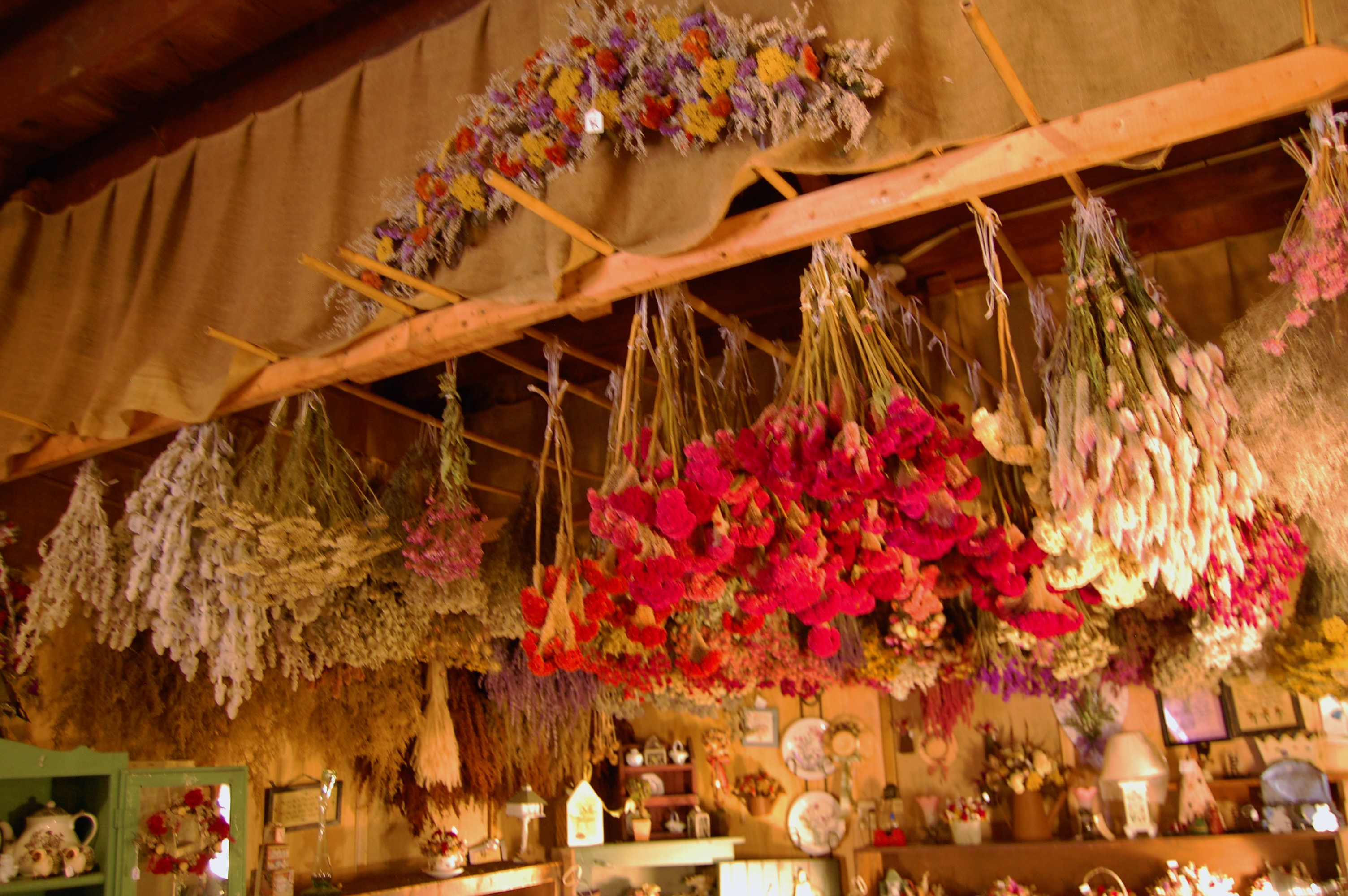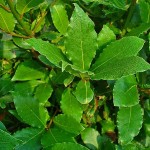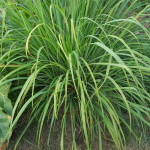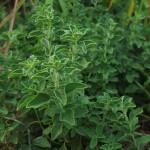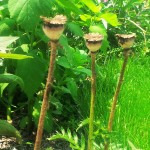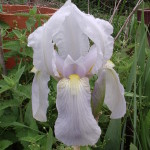How and when you harvest your herbs depends on how you plan to use them. In general, you should harvest your herbs early in the morning after the dew has dried. This is when their flavor or essential oils are at their peak.
Annual herbs can be harvested any time up to your first frost. You should stop harvesting your woody perennial herbs about a month before your first frost. Harvesting is similar to pruning and stimulates growth. New growth needs time to mature or harden before winter. Otherwise it will be too weak and may not survive the winter.
Leaves
You should wait to harvest leaves from your plants until they have enough foliage to sustain growth. Once you begin harvesting, you can remove up to 75% of the leaves at one time. Leaves should be harvested before the plant flowers or very often the taste will become bitter. You can prevent flowering by removing buds before they open. Basil is a good example of this. You must be vigilant all season and remove any buds that appear if you wish to harvest basil leaves all summer.
Bay Laurel (Laurus nobilis) Bay laurel is a tree that grows 30’ to 60’ tall and is hardy in zones 8 through 10. Most of us grow bay laurel in containers. Container grown bay should be kept pruned to 6’ maximum. You can begin harvesting leaves when your tree is 2’ tall. Once it has attained this height, you can harvest the leaves any time of year. Most of us must bring our bay laurels indoors during the winter, so it will continue growing and producing leaves all year so we can harvest all year. Always harvest the largest leaves. They contain more of the essential oil (eucalyptol) that gives the leaves their distinctive flavor. The leaves need to be dried before use. Fresh leaves are very bitter.
Lemongrass (Cymbopogon citratus) Lemongrass is a tropical grass that is used in Asian cooking. It can be grown in a container and brought indoors during the winter or it can be grown in your garden as an annual. It is only winter hardy through zone 9. If grown in a container, you can harvest leaves year-round but if you are growing it in your garden, you can harvest leaves until it dies after the first frost. Stalks should be ¼” to ½” thick and cut at ground level. You can use them fresh or freeze them up to 6 months. Lemongrass can also be dried and used in herbal tea.
Oregano (Origanum vulgare) Oregano is a perennial herb that is hardy in zones 5 through 8 depending on the variety. It dies to the ground in the winter. Although it is possible to harvest leaves from your oregano plant during the growing season, oregano provides you with two full harvests each year. The first harvest should be made before it flowers. Like basil, if allowed to flower, oregano will become very bitter. As soon as you see buds forming (end of May/beginning of June), cut your plant down to the ground. New growth will appear within 2 to 3 weeks. It will continue to grow until killed by the first hard frost. Be sure to harvest your oregano before the frost, cutting the entire plant down to the ground again. New growth will appear the following spring.
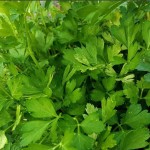
Flat Leaf Parsley
Parsley (Petroselinum crispum) Parsley is a very hardy biennial in zones 3 through 9. When harvesting your parsley, cut the outer stems first, leaving the center growing tip intact. If you are not using your parsley harvest immediately, you can keep it fresh by placing it in a glass of water and storing it in your refrigerator.
Flowers
If you are harvesting herbs flowers for flavor or scent, you should do it before they actually bloom. Herb flowers have their highest concentration of essential oils when the buds form. That concentration falls as the buds open.
On the other hand, if you want to harvest herb flowers to dry for use in flower arrangements or crafts, you should harvest them after the buds have started to open but before they are fully open.
Chamomile (Matricaria recutita) German chamomile is an annual and most often used for herbal teas. Only the flowers are used for tea. The foliage is bitter. People who find chamomile too sweet add a few leaves to their tea to offset the sweetness. German chamomile has its highest concentration of flavor when the flowers are fully open. Fully open in this case means that the petals as drooping. You can use garden shears to remove the flowers from the plants. Be sure to leave a few flowers on your plants to make seed for next year. German chamomile readily self-sows itself in your garden.
Rose (Rosa spp) Roses are another flower that you want to harvest when it is fully open. Harvest them in the morning when the flowers are freshly opened. If you plan to use the flowers fresh, wash them thoroughly to remove any soil, insects or insect eggs. If you plan on drying your roses, do not wash them. You don’t want to add more moisture to them. Remove the individual petals and dry them in a single layer on a screen or in a food dehydrator.
Rosehips are the fruit of the rose bush. They are best harvested after the first frost when their flesh is at its sweetest. Simply snip them off the plant and remove the seeds as soon as possible after harvest. You can use the remaining flesh fresh or dried.
Seeds
Since you cannot see the seeds to know when they are ready for harvest, you use the seed pods as an indicator. When the pods have turned brown or gray, the seeds are ready for harvest. I like to use a paper bag, putting it over the seed head then holding the bag shut as I clip the stem. The seed pods can be left to finish drying in the paper bag if you cut holes in it for ventilation.
Dill (Anethum graveolens) and Fennel (Foeniculum vulgare) both dill and fennel produce seedheads in an umbel structure. The seeds are held very loosely and spread by the wind or when the plant is disturbed by an animal passing by. This makes it very difficult to harvest the seed. There are two ways to get around the plant dispersing its seeds at the slightest touch. The first way is to wrap the umbel in cheesecloth and then cut the stem. The umbel can then be dried in a paper bag with slits cut into the sides to provide circulation. Or you can skip the extra step and simply place a paper bag over the umbel, close it off with one hand while cutting the stem with the other. Then all you need to do is cut the slits in the sides of the bag.
Poppy (Papaver somniferum) Poppy seeds can be difficult to harvest if you are trying to get every seed out of the seed pod. Simply removing the top of the seed pod and pouring out the seed won’t work because a few seeds always get stuck in the curved bottom of the chambers inside the pods. Trying to break each chamber open individually results in a lot of debris in your seeds. The best tool I’ve found for the job is my flour sifter. I place it in a mixing bowl, drop my poppy seed pods into the sifter and then simply sift! The rotator breaks open the pods and the tiny mesh prevents everything except the seeds to fall through into the bowl. Problem solved.
Roots
Most roots are harvested in the fall when the foliage begins to dry.
Ginger (Zingiber officinale) Ginger is another tropical perennial that most of us grow in containers because it is only winter hardy in zones 9 through 12. The root needs 10 months to reach maturity. When the foliage starts to die, it is time to harvest. Ginger roots are unusual because you can harvest small pieces, known as green ginger, before they reach maturity without harming the root or the plant. Simply dig very carefully around the root and remove a small piece. The taste won’t be as intense as the taste of mature roots.
Orris Root (Iris florentina) Orris root is the rhizome of a variety of German iris, the Florentine iris. The powdered form is used by the perfume industry as a fixative. It smells of violets. To produce orris powder, the rhizome needs to be at least 3 years old. Dig it up in the fall and dry it for at least 2 years. Freshly dug rhizomes have no scent. You will know when your rhizome is fully dry because it will be very light and smell like violets. You can then grind it up into powder.

